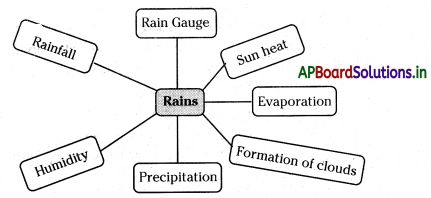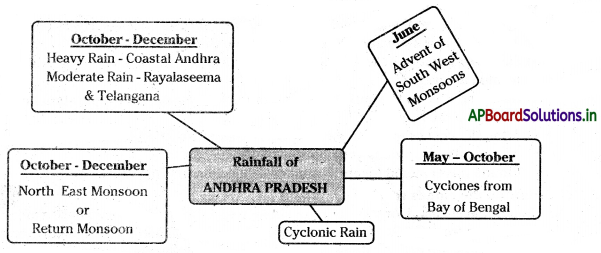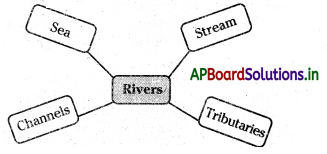Students can go through AP State Board 7th Class Social Studies Notes Chapter 2 Rain and Rivers to understand and remember the concept easily.
AP State Board Syllabus 7th Class Social Studies Notes Chapter 2 Rain and Rivers
→ All life on the earth is very crucially dependent upon water.
→ As you know over 71% of the earth’s surface is covered with water.
→ We depend upon water for growing crops. But we do not get water uniformly over the year.
→ After the unbearable heat of April, May and June, comes the rainy season, which lasts for a few months.
→ Water in the cloth or in the plate becomes water vapour and mixes with the air through a process called ‘evaporation’.
→ There are several water bodies on the earth’s surface – oceans, rivers, lakes etc.
→ There is constant evaporation of water from these water bodies.
→ Formation of clouds and Rain: When water vapour rises with hot air and reaches high up in the sky, it gets cooled. This is because it gets cooler as we rise above the surface of the earth. With the cooling, water vapour is transformed into tiny water droplets. Change of water into vapour is known as evaporation.
→ The process of water evaporating from the seas, forming clouds in the sky, coming down like rain. Different forms of condensation of water vapour are known as precipitation.
![]()
→ The amount of invisible water vapour present in the atmosphere is known as humidity. The winds come all the way from the Arabian Sea and the Bay of Bengal and they transport the rain clouds. They are called ‘Monsoon winds’. They are also called ‘south-west monsoon winds’ as they blow from that direction. These winds blow only in the summer.
→ There are two arms of the monsoon winds: one blows from the Arabian Sea and the other from the Bay of Bengal.
→ The southwest monsoon, however, brings much rain to the Telangana districts as the winds again rise over the Eastern Ghasts.
→ In the months from May to October, cyclones form in the Bay of Bengal causing widespread rains in coastal and inland Andhra Pradesh.
→ Rain caused by whirling storms is called cyclonic rain.
→ The cyclones are formed in the sea due to intense heating up in summer.
→ An instrument by which the rainfall is measured is known as ‘rain gauge.
→ The amount of rainfall for a unit area is measured in centimetres.
→ Rivers or streams which join a larger river are called ‘tributaries’.
→ Rivers like the Krishna and the Godavari start from the Western Ghats, which receive heavy rains.
→ The treeless bed is called the floodplain of the river.
→ Vegetation covers on land obstruct the runoff rainwater and slow down the speed of its flow. Vegetation reduces the erosion of soil by rainwater.
![]()
→ If the surface of the land is covered with vegetation, then soil erosion is greatly reduced. The worst cyclone hit the state in November 1977.
→ Recently in 2018 Titles cyclone created huge destruction in North coastal Andhra, Srikakulam.
→ Cyclones and floods are seasonal phenomena.
→ Rivers and Tributaries: A river is usually in the form of a thin stream. As it flows further it gets bigger and broader. This happens because many small streams join it as the stream flows. Rivers or streams which join a large river are called tributaries
→ Condensation: Drops of water that form on a cold surface when warm water vapour becomes cool.
→ Annual rainfall: In the months from May to October cyclones form in the Bay of Bengal causing widespread rains in coastal and inland Andhra Pradesh.
→ Flood plain: Every year when it rains heavily, the river trough is filled with water allowing no permanent trees or plants to grow there. This treeless bed is called the flood – plain of the river.
→ Cyclone: A violent tropical storm in which strong winds move in a circle.
→ Monsoon: The rainy season.
→ Hail: ice pieces of frozen vapour falling in showers.
→ Famine: Scarcity of anything.
→ Slums: An area of the city that is very poor ànd where the houses are dirty and in bad condition
→ Vegetation: Plants ¡n general especially the plants that are found in a particular area or environment
![]()
→ Western Ghats: The Western flank of the Deccan plateau ¡s guarded by the Western Ghats.
→ Eastern Ghats: The Eastern ghats are much less strongly marked than the Western Ghats. They are from the Eastern boundary of the Deccan Plateau.
→ Drought: Famine; a condition where there ¡s no rainfall.


